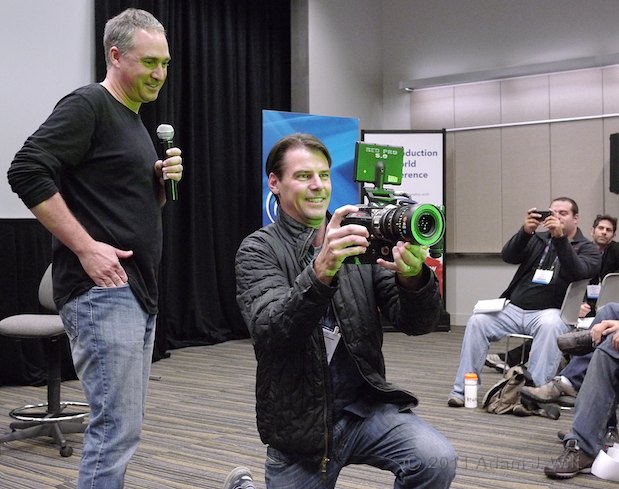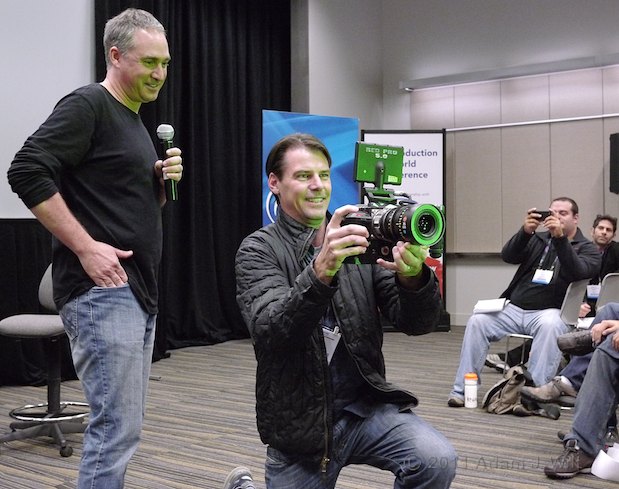
DP Brian Pearson wields an EPIC as RED’s Ted Schilowitz watches.
On Sunday I sat in on several classes and sessions, to get a feel for the non-show-floor goings-on at NAB. Herewith, my fragmented, barely-edited notes.
DP Discussion
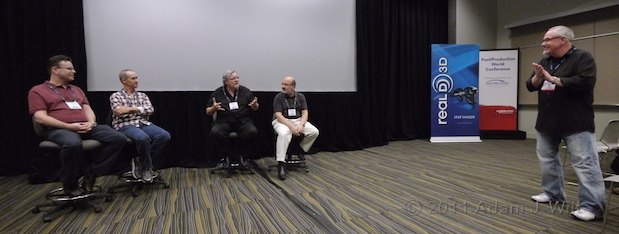
Gary Adcock leads a discussion by DPs.
Gary Adcock hosted a panel of DPs—Geoff Boyle (Dark Country, Mutant Chronicles, Wallander), Roberto Schaefer (Quantum of Solace), Michael Bravin (BandPro, Arriflex), and PVC’s own Art Adams—in a freewheeling discussion of industry issues, as part of the Post|Production World workshops.
On shooting film for 3D, and shooting film in general: Geoff suggests, “put two Arri 416s on a rig, it’ll be lighter and cheaper and better quality than digital. If you need to reposition in post, just scan at a much higher resolution than your output, and you have great flexibility.” And: “look at the original Star Trek: shot on 35mm for SD release. Along comes HD, rescan the camera masters, and sell it again. If UltraHD comes along, do the same thing. If you shoot film, you can do that. If you shoot video, well…”
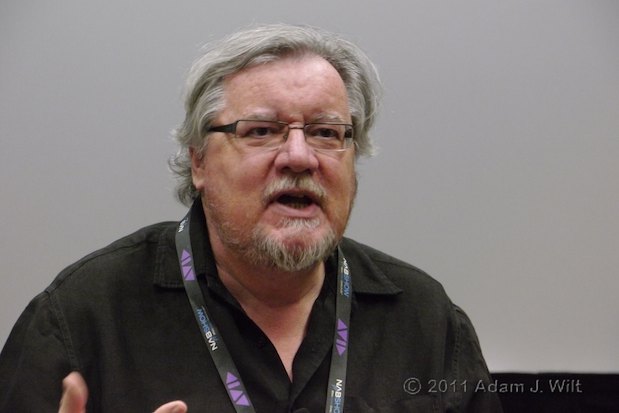
DP Geoff Boyle.
On the democratization of the toolset: Geoff: “Writers can write with pencils, typewriters, word processors, or crayons. You start a kid on a crayon; if he proves he can be trusted with a crayon, you might give him a pencil. Canon [HDSLRs] are like crayons.” Roberto, quoting a Korean director who shot a feature on iPhones: “Why use an iPhone? You can put the camera anywhere, and anyone can operate it!”
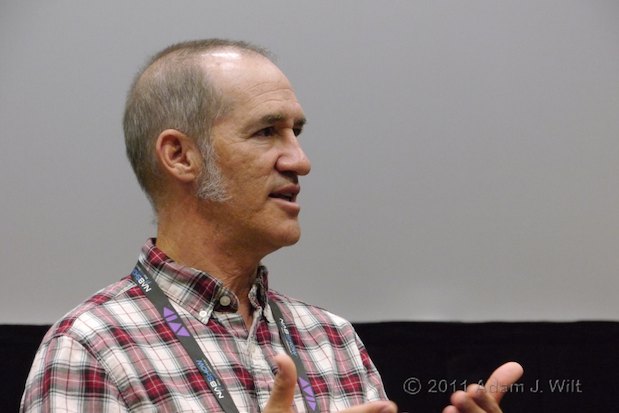
DP Roberto Schaefer.
But when anyone can shoot an image, the craft of image-making is often lost. Art judged a Sony-sponsored student film festival: “80 films, but only three and a half were any good. The rest were all ‘set the camera on auto, turn it on, and we’re done’. No sense of composition, lighting, or telling a story visually.” Roberto agrees: “you’re not photographing, you’re just recording.” Getting an exposure is one thing (and with crazy-sensitive cameras these days, you don’t need much light); actually shaping the light and creating a look is something else altogether.
The trick, of course, is to find producers and directors who still value careful cinematography as an essential port of telling a story.
On budgets and budgeting: too much production is fragmented into islands, each of which only cares about its costs regardless of the pain it causes elsewhere. Geoff worked on a spot that needed a £26,000 lighting budget for a single wide shot, but production said, “light just a small chunk on your usual daily lighting allowance and they’ll clone it in post.” So he did, and they did… saving £20,000 in production, but spending an additional £50,000 digitally duplicating the lit part into the rest of the scene, and even so, it looked like crap. But production saved £20,000 and that’s what mattered!
Corporate organization matters, too: On the episodic TV show “Wallander”, the
BBC’s version cost €2,000,000 / episode, the Swedish version €400,000 / episode: the difference was the bureaucracy involved at the BBC.
It’s essential to have the Director stand up for the DP and the crew; if the Director won’t ask for the kit, the Producer won’t pay for it.
Work for free IF it’s good for you. Don’t work for free because you think it’ll advance you.
Creating a Healthy Relationship with Your Director of Photography
Director/Producer Richard Harrington and DP Jim Ball gave a talk on “Creating a Healthy Relationship with Your Director of Photography”, also part of Post|Production World. It was attended by a mixed crowd of DPs, Directors, and Producers. The presenters started off with the xtranormal clip “Cinematographer vs Producer” to illustrate the problem. Jim says he’s had conversations like that—in spirit, if not in tone!
You need to establish a good relationship, getting off on the right foot. Start off with “are you available?” If schedules don’t work, nothing else will. Only then confirm qualifications (and share where the lead came from; most freelance work is from referrals). Describe the project and confirm mutual interest: most DPs will self-select (or voluntarily opt out) when the project and its approach match with the DP’s capabilities, enthusiasms, and equipment. Often the best DPs have their own cameras (this is from a Washington DC perspective of documentary and corporate production, not the Hollywood feature-film worldview), and they’re so familiar with it that it’s an extension of their mind, not a bit of gear to get in the way.
Discuss budgets and rates, and be prepared to negotiate back and forth (“like a market in Marrakesh”!). Make sure the DP has the time to talk (e.g., he isn’t on-set when you called); arrange a time for follow-ups with more details, creative meetings, etc. Don’t forget to send a deal memo or a written summary after this first call, so the DP has a reference, and ask for an acknowledgement.
Freelancers care about the difference between “hold” and “book” (“hold” means “try to keep the date free in case we move forward”, while “book” means “we are moving forward and employing you on these dates”)!
Q: How useful is a reel in picking a DP? A; Great question; take in combination with references, your feel for the DP, etc. Unethical DPs may have other people’s stuff on “their” reel. Look also for shared connections, LinkedIn, etc.
Q: How to deal with cancellations? Half-day pay for a cancelled day? A: There’s no standard. 24 hours cancellation notice is nice. There’s a difference between canceling and postponement (and if it’s postponed, are you available that day?). A good deal memo helps cover these contingencies.
Choose the right DP for the job: personality is as important as prowess. Solo shooter or crew master? Depends on the job. Dominant needs: technical, political, creative, managerial, efficiency, a combination thereof? Wrong reasons: free gear, cheap labor, unqualified relations, political appointees!
“Think more like a businessman, less like an artist.”
Try to pay the DP something during preproduction—it’s hard to be involved with a project if you’re not being paid. If you share production details with the DP, the DP can catch things (like no AC hired for a Steadicam shoot) that would be problems, and can help craft the vision. Call sheets, talent, locations, corporate style guides, color palettes—all this stuff is helpful.
PDFs are the lingua franca of electronic communications: don’t put everything in the cloud (crews on set may not have connectivity), and don’t distribute Office / Photoshop / Final Draft / camera raw / etc. formats, because not everyone has the same software.
Keep 5%-10% of your budget flexible, to cover contingencies.
On-set: DP, Producer, Director form a team; each has to support the others and be aware of the others’ roles. Open communications, listening, empathy are essential. If you have to have a “serious discussion”, walk away from the set and the crew and talk in private to work out differences.
In post, don’t forget to involve the DP in color grading.
How does Richard pick a job? “Does it look good on my reel, will it pay well and quickly, do I like the people?”
Filmmaker’s Views on Advances in Image and Sound
Douglas Trumbull (2001, Silent Running, Brainstorm) talked at the NAB/SMPTE Digital Cinema Summit about high frame rates and large images.
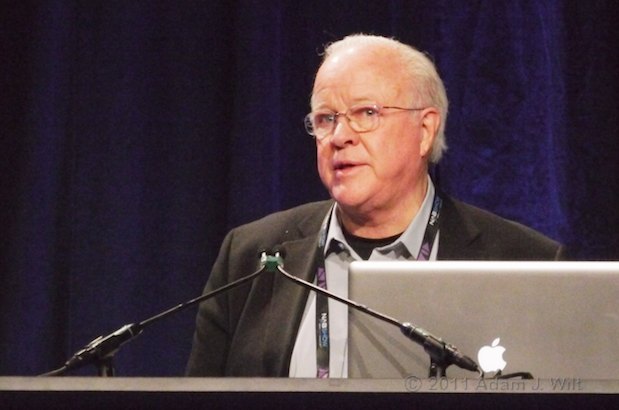
DP/Director/VFX Guru Douglas Trumbull.
“It’s not just about high frame rates, 3D, giant curved screens, it’s everything together.” Cinerama and peripheral vision. “How the West Was Won”; “2001”, or as Kubrick called it, “How The Universe Was Won”. Shutter angle and blur were critical. “Around the World in 80 Days” shot at 30fps to reduce widescreen judder.
At 48flashes/sec, 16 fL (foot-lamberts) is the max screen brightness, else flicker is perceived.
3D 24fps: blurring and strobing. If interframe displacement exceeds left/right disparity, 3D effect is lost. DLP projectors are capable of 144fps, so the potential exists for high frame rate display. At Future General company, looked for more immersive cinema: revisited all the ‘scopes [widescreen formats], only then tried higher frame rates: Showscan resulted (65mm 60fps). 2.2:1 aspect ratio, varying frame rates. Side by side tests of 24fps vs. other rates; 66fps was the place where physiological differences set in; “indistinguishable from reality”. “Brainstorm” supposed to mix Showscan and regular 24p material, but wound up mostly released as 24fps 35mm due to theater requirements.
Cameron testing 24/48/72 fps, Jackson wants 48fps for Hobbit. Technical issues: Trumbull saw “Avatar”, didn’t realize that current cinema could look that way. 3D is a definite advantage: this geeky technical movie could also be the highest-grossing film of all time.
Don’t think high frame rates are an industry threat. “Suggest that filmmakers use the technology appropriate to the film.” (applause)
Current cinematic language may not work so well in immersive large-screen films. “2001” a good example of something that almost entirely dispenses with “standard melodramatic conventions”, but it works on the big screen (and only on the big screen!). OTS shots may not work in large-screen IMAX, for example. Making a movie that plays successfully in multiple formats is very difficult.
Issues: at 48fps, you can’t drop every other frame for 24fps: lose blur. At 60fps, no way to get back to 24fps smoothly (3:2 pulldown reversal). Patent application: temporal continuity: every new flash of light onscreen should have new motion. No double-flash (and double-imaging during saccades [rapid eye movements]: judder, strobing). Digital Showscan: 24fps movies with 60fps fast-action sequences in it. Shoot 120 fps, blend 3 frames and drop 2 to get 24fps. Drop every other frame for 60 fps, etc. Not for all films; use appropriately. Phantom Gold 2K used for Showscan Digital demos. 20-30 fL is Trumbull’s sweet spot. Phantom Z3D (Abel Cine) for high-frame-rate 3D. “I plan to shoot my next feature film with it, because I can’t help myself!” (applause) Trumbull’s new company: Magnetar Productions.
Faster pixels from Higher Frame Rates
This DCS panel was moderated by the EBU’s Dr. Hans Hoffman.
David Stump ASC: likes what Doug Trumbull showed. 4 vectors for quality: high bit depth (IIF), high res (4k+), high frame rates (48-90fps), brighter screens.
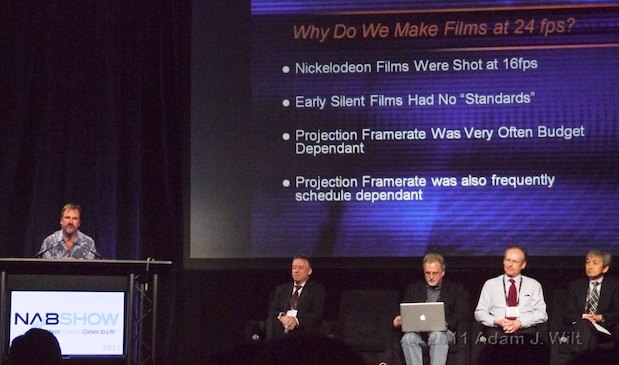
DP Dave Stump
History: 16fps; hand-cranked cameras; then 24fps for sound; then 30fps for Todd AO. Variable frame rates nothing new.
Moe Shore of Abel Cine: high rates for high rate playback, or for standard playback. Showscan said to be “Not some sort of gimmick like 3D or Cinerama”! Demos of slo-mo in films, TV, sports. Digital is cheaper than film in high-frame-rate uses (stock and processing costs, even if digital cameras are costlier to rent), but speed and ease of use are important, too. New genre: Google’s Chrome Speed Test.
In broadcast: Richard Salmon, BBC: TV rates chosen for flicker, mains power compatibility. 50/60 OK for SD on small CRTs, NG for HD on big screens. Loss of detail due to blur. Panning blurs the entire screen (e.g. panning to follow action in a football match). As resolution increases, panning has to slow down… or frame rates need to increase. Dynamic res of HD is the same as for SD at same frame rate. High static res requires high dynamic res, else nausea (sharp/soft/sharp). Upconverting TVs (240 Hz) not the solution; need higher rates in shooting. HD needs 100-150 Hz; 4k needs 300 Hz? 300 downconverts to both 50Hz and 60 Hz; 600 Hz downconverts to 24, 25, 50, 60, 120, 150. Needed only in camera, not in delivery?
Masayuki Sugawara, NHK on UHDTV: biggest problem is motion portrayal: flicker, blur, stroboscopic effect. Ultimately, no artifacts = human visual system (note also that most LCDs hold the image for the entire frame time, adding motion blur during saccades).
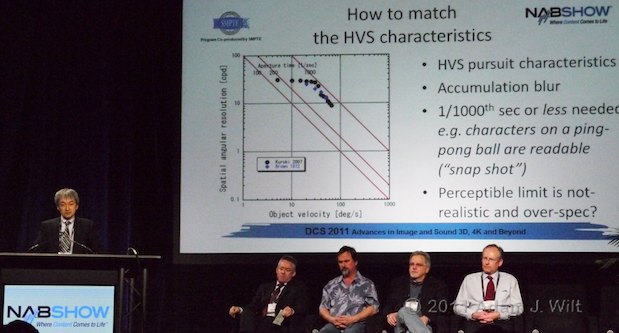
Masayuki Sugawara, NHK
Flicker fusion rates from 65fps to perhaps 80 fps for widescreen presentations; motion blur noticeable around 2 pixels/frame, but this is too demanding for current tech, acceptable around 1/320 sec, or 320 Hz displays. Stroboscopic effect tested using 720p material, acceptable limits around 100+ Hz. Dynamic visual acuity increases by 1.8x as FOV goes from 10 to 110 arc degrees; future wide FOV TVs will require higher dynamic resolution. Conclusions: 80+ Hz required to eliminate flicker; 1/320 exposure aperture for blur, 100Hz for strobing.
Rob Hummel points out the flicker issues of frame rates vs powerline frequencies in lighting; that’s why the 66 fps sweet spot of Showscan was backed off to 60 fps.
Dave Stump advocates DCPs with variable frame rate content in it.
(I find it interesting that film folks are talking about 48fps – 60fps as the high frame rate target, while the TV folks are starting from 50/60 Hz and wanting to move to 100-300 Hz!)
EPIC in 3D
Ted Schilowitz presents another P|PW session, “EPIC in 3D”
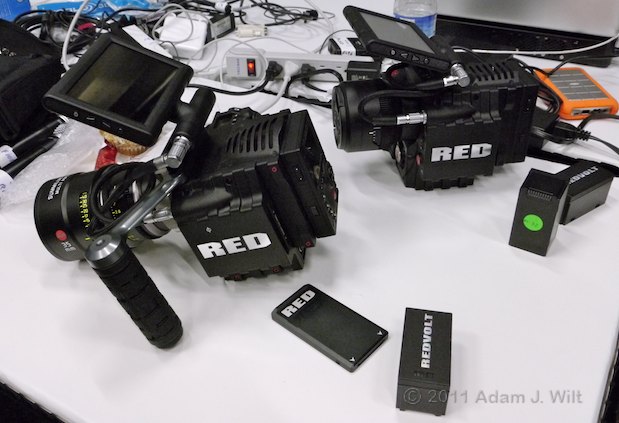
A RED EPIC, a Scarlet, and accessories.
Jackson’s “Hobbit” in 3D using 3ality rigs, shooting 48fps to deliver 48fps (EPICs allow shooting high frame rates as base frame rates). Many other big 3D movies being shot on EPICs. “Pirates of the Caribbean IV” shot in 3D on RED ONEs. “Indie 3D” projects enabled by the light weight of the EPICs (5 lbs); two cameras and lenses on a rig total a mere 40 lbs—lightweight and maneuverable by 3D standards—without sacrificing resolution and quality.
Shutter roll/reset times: RED ONE 8msec, EPIC 5msec, film cameras 4msec.
M-X and EPIC nominally rated at EI 800 (best balance between highlight headroom and shadow noise); 320-2500 recommended range. RED ONE to 1600, EPIC to 2000 before noise becomes a serious issue.
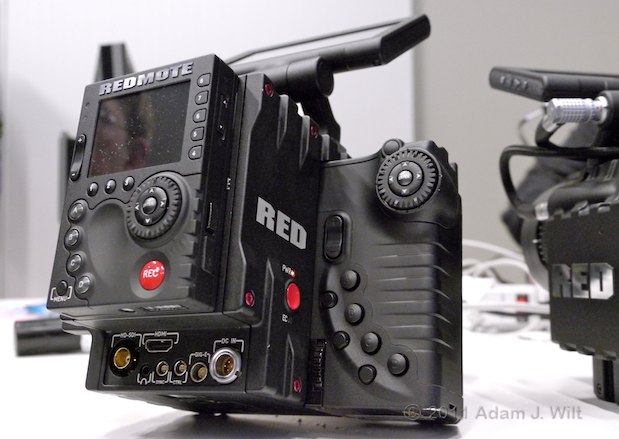
EPIC back end with a REDMOTE remote control.
EPIC sensor is actually a bit larger than the RED ONE M-X; the R1 M-X isn’t just a windowed image off the EPIC-sized sensor.
HDRx will be available on both EPIC and Scarlet. You should be able to shoot up to half the max frame rate of a non-HDRx clip in HDRx.
Ted got DP Brian Pearson out of the audience to shoot some footage with an EPIC; Travis from RED used a mobile RED ROCKET system and a RED SSD reader to play the R3D files out to 1080p in real time, with a one-light grade applied in real time, illustrating the speed and ease of use of RED footage… when you have a ROCKET card! At $3000 used or $5800 new, ROCKET is “basically free when you’re talking about real-world film equipment prices.”
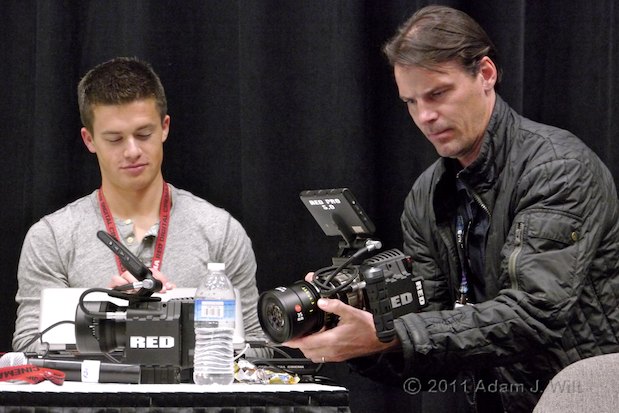
Brian Pearson shoots a Scarlet with an EPIC.
EPIC availability: hundreds shipped so far. The “Japan problem” is slowing deliveries; “at some point we’re gonna run out” of parts for EPIC-M deliveries. And after that? Who knows…
FTC Disclosure
I’m attending NAB 2011 on a press pass, which saves me the registration fee or the bother of using one of the many free registration codes offered by vendors. I’m paying for my own transport, meals, and hotel.
No material connection exists between myself and the National Association of Broadcasters; aside from the press pass, NAB has not influenced me with any compensation to encourage favorable coverage.

Filmtools
Filmmakers go-to destination for pre-production, production & post production equipment!
Shop Now